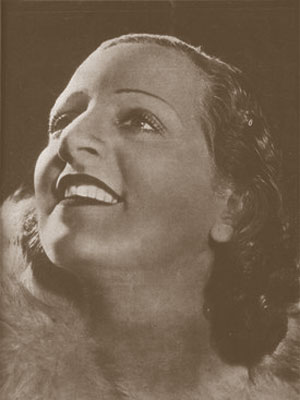Early Life
Ada Falcón was born on August 17, 1905, on the estate “Los Paraísos” in Ituzaingó, Buenos Aires, Argentina. She was the youngest daughter of Miguel Nazar Anchorena, a Tucumán rancher with fields in Junín, and Cornelia Boesio. Ada had two older sisters, Amanda and Adhelma, both of whom were also singers, although not as widely recognized as Ada.
Artistic Aspirations from a Young Age
Ada Falcón’s inclination toward the arts manifested early in her life. At the age of four, she expressed her desire to sing to her mother. Shortly thereafter, she made her debut as the “joyita argentina” (Argentine jewel) at the Sociedad de San Vicente de Paul. Her mother played a pivotal role in shaping her artistic identity, shortening the family name to “Falcón” for her stage name.

Artistic Ascendancy
July 15, 1925, marked a significant turning point as Ada Falcón began recording with the RCA Victor label, accompanied by the orchestra of Osvaldo Fresedo. Her mezzo-soprano voice set her apart from the higher-pitched voices of her contemporaries.
Subsequently, she formed a decade-long artistic partnership with renowned musician Francisco Canaro, resulting in numerous iconic recordings and live performances.
Cinematic Ventures
Falcón expanded her artistry to the silver screen, appearing in films such as “El festín de los caranchos” (1919), “Tu cuna fue un conventillo” (1925), and the sound film “Ídolos de la radio” (1934). Her impact on tango extended beyond the music, leaving an indelible mark on Argentine cinema.
The Canaro Connection
Her romantic involvement with Francisco Canaro, marked by the composition of the famous vals “Yo no sé qué me han hecho tus ojos” inspired by Falcón, added a layer of complexity to her life. Despite their deep connection, she abruptly retired in 1942, spending the rest of her days in seclusion in Salsipuedes, Córdoba.
10 Most Important Tango Songs by Ada Falcón
Here is a list of 10 important tango songs by Ada Falcón, along with their recording year, orchestra, singer, and a brief description of each song:
- “La Cumparsita”
- Recording Year: 1937
- Orchestra: Osvaldo Fresedo
- Singer: Ada Falcón
- Description: This classic tango, recorded in 1937, showcases Ada Falcón’s emotive interpretation, accompanied by the elegant arrangements of Osvaldo Fresedo. “La Cumparsita” remains a timeless piece in tango history.
- “La Morocha”
- Recording Year: 1929
- Orchestra: Francisco Canaro
- Singer: Ada Falcón
- Description: A lively tango recorded in 1929, “La Morocha” marks the beginning of Falcón’s collaboration with Francisco Canaro. The dynamic rhythm and Falcón’s spirited performance make it a favorite for tango dancers.
- “Yo no sé qué me han hecho tus ojos”
- Recording Year: 1934
- Orchestra: Francisco Canaro
- Description: This vals, recorded in 1934, is a heartfelt composition by Francisco Canaro inspired by Falcón’s captivating eyes. The song beautifully combines romance and melancholy, leaving a lasting impression.
- “Corazón Encadenado”
- Recording Year: 1942
- Orchestra: Francisco Canaro
- Description: Recorded in 1942, “Corazón Encadenado” is a poignant tango that serves as Ada Falcón’s farewell to the music scene. The song reflects the bittersweet emotions of concluding a remarkable career.
- “Tres esperanzas”
- Recording Year: 1934
- Orchestra: Francisco Canaro
- Description: An evocative tango recorded in 1934, “Tres esperanzas” showcases Falcón’s ability to convey deep emotions through her voice. The collaboration with Francisco Canaro resulted in a tango that stands the test of time.
- “Envidia”
- Recording Year: 1934
- Orchestra: Francisco Canaro
- Description: Recorded in the same year as “Tres esperanzas,” “Envidia” is a tango that captures the essence of Falcón’s expressive singing. The song’s themes of envy and passion resonate with tango enthusiasts.
- “Destellos”
- Recording Year: 1934
- Orchestra: Francisco Canaro
- Description: “Destellos,” recorded in 1934, is another gem in Falcón’s repertoire. The tango is characterized by its nuanced orchestration and Falcón’s ability to convey intricate emotions through her vocals.
- “Corazón de oro”
- Recording Year: 1934
- Orchestra: Francisco Canaro
- Singer: Ada Falcón
- Description: With its melodic richness and poetic lyrics, “Corazón de oro” is a standout tango from 1934. Ada Falcón’s collaboration with Francisco Canaro produced a piece that remains cherished by tango aficionados.
- “La pulpera de Santa Lucía”
- Recording Year: 1934
- Orchestra: Francisco Canaro
- Singer: Ada Falcón
- Description: This tango, recorded in 1934, narrates the story of “La pulpera de Santa Lucía.” Falcón’s expressive rendition, combined with Canaro’s orchestration, brings the narrative to life.
- “Caminito”
- Recording Year: 1934
- Orchestra: Francisco Canaro
- Singer: Ada Falcón
- Description: “Caminito,” recorded in 1934, is a beloved tango that captures the essence of nostalgia and longing. Falcón’s interpretation, accompanied by Canaro’s orchestra, makes it a timeless piece on tango playlists.
Retirement and Later Life
Withdrawal and Spiritual Journey
In a surprising move, Ada Falcón withdrew from the limelight in 1942, selling her belongings and residing in a convent in Salsipuedes. Rumors circulated about her embracing a religious life, earning her the moniker “puta a los 20, monja a los 40” (prostitute at 20, nun at 40). Her active religious engagement hinted at a significant life change.
Later Years and Passing
Ada Falcón spent her later years in obscurity, residing in a retirement home. She passed away on January 4, 2002, at the age of 96, succumbing to arteriosclerosis. Her final resting place is in the SADAIC pantheon in the Chacarita cemetery, close to Francisco Canaro.
Legacy
In 2003, the documentary “Yo no sé qué me han hecho tus ojos” paid tribute to Ada Falcón’s life, providing a poignant reflection on her enigmatic journey. Directed by Sergio Wolf and Lorena Muñoz, the documentary received critical acclaim and several awards, including a Cóndor de Plata.
Her former residence in Salsipuedes has been transformed into the Casona & Museo La Joyita, a private museum housing memorabilia from Falcón’s life. This dedication reflects the enduring impact she had on Argentine culture.
FAQ about Ada Falcón
Q: Why did Ada Falcón retire suddenly in 1942?
A: The exact reasons for Ada Falcón’s sudden retirement in 1942 remain somewhat mysterious. Some speculate it was influenced by her tumultuous romantic relationship with Francisco Canaro, while others suggest personal and spiritual considerations.
Q: What is the significance of “Yo no sé qué me han hecho tus ojos”?
A: This vals holds significant emotional weight as it was inspired by Canaro’s admiration for Falcón’s captivating eyes. The song beautifully encapsulates the essence of love and longing, making it a timeless piece in the tango repertoire.
Notable Sources:
- Wolf, Sergio, and Muñoz, Lorena. “Yo no sé qué me han hecho tus ojos” (2003).
- Clarín. “Ada





